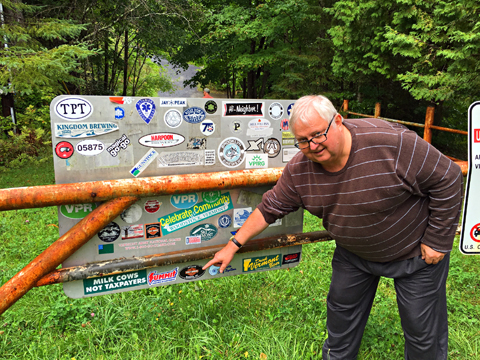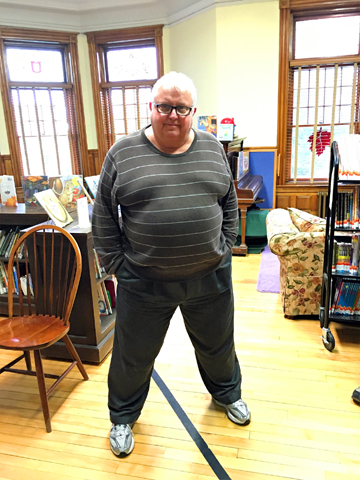|
 |
|
Click above image to enlarge |
In mid-September I took a week’s vacation to go on my fourth border tour
with the
Center for Immigration Studies (CIS), an organization based in
Washington, DC. On every annual
tour we drove around in two SUVs usually with four staffers from the
Center and 6-8 interested parties like me. I’ve been to the southern
border of Arizona, the southwest border
of Texas and last year, San Diego, California — all areas bordering
Mexico. The purpose of these trips (about six days each) was to get
firsthand knowledge of the problems facing these states with illegal
alien crossings. We met with local officials, retired border patrol
agents, and ordinary folks impacted by the flight into the United
States.
This year the Center decided to tour the northern border, starting from
the capital of Canada — Ottawa — and moving slowly across northern New
York and Vermont to examine it for illegal border activity. Our group
this year was fortunate to have with us Jessica Vaughn, from CIS who
also happens to live in Franklin, Massachusetts and is a frequent
attendee at my monthly Friday Morning Group meetings in Lexington.
 |
|
Click above image to enlarge |
I
drove up to meet our group and begin the trip at Ottawa, and of course I
had to first make a border crossing. That was an experience in itself.
At the checkpoint, the border official asked several questions, and then
asked me to pull over and enter a small customs building for further
questioning. After waiting inside for half an hour in a nearly empty
waiting room, I went up to the counter and asked what the problem was.
An official came to the counter and proceeded to ask me the same
questions all over again! Then said in a condescending voice: “You know
that you are a guest in our country and we are the ones who allow you to
enter.” You mean the country whose high taxes make ours look low by
comparison, you mean the country that has overly-restrictive gun laws,
you mean the country that’s health care system is so bad that US
hospitals along the border are flooded with Canadian patients
needing urgent medical attention! Confession: I had those thoughts, but
didn’t express them: otherwise I might still be detained at that
crossing.
The first two days were spent on a Mohawk reservation in upstate New
York. We actually stayed at the casino located on the reservation.
Unlike the images many people may have of an Indian reservation,
traveling through it in many ways was like going through a working class
suburb of Boston — only with more land between houses.
|
 |
|
Click above image to enlarge |
However you know
you’re not in the Boston suburbs when business signs are spotted like:
The Medicine Chest, Mohawk Plumbing and Wolf Pack Gifts. Incidentally,
we were told it is true that Mohawks are employed as construction
workers on skyscraper, mainly in New York City. Quipped one Indian:
“having a great sense of balance comes in handy.” The border problem in
this area was not so much illegal alien activity, as illegal cigarette
sales. It’s perfectly legal to sell cigarettes tax-free on the
reservation, but huge amounts find their way off the reservation which
makes them illegal.
One big difference in this trip, as opposed to my three trips to the
Southwest borders, was the absence of walls and/or barriers to prevent
crossings. Instead our group examined many areas where a gate or simple
fence across a street prevented any crossings. Some had signs in French
saying “Chemin Ferme” meaning “Road Closed.” Most had some sort of
sensor or camera on a 20 foot pole to detect activity. In the aftermath
of 9/11 no longer can Canadian and American neighbors cross casually
back and forth. A few times when we arrived at a barrier, a border
patrol agent would arrive within minutes to question the group. One
spot, however, only had a seven foot stone pillar designating the border
from which one could view a wide expanse of open land.
 |
|
Click above image to enlarge |
I
have to say every retired or active border patrol agent who we talked to
during our trip was courteous, informative and happy to answer
questions. I found out that most border patrol personnel are first
assigned to the “hot spots” in the Southwest before any transfer to
northern Vermont and New York. One agent told me that “walls work.” His
previous tour had been near Yuma, Arizona, and when fences went up the
number of detainees dropped from 900 to 60 a day.
We talked with Debra Smith, whose home is exactly on the borderline.
Remember the two murderers who
escaped from the Clinton Correctional Facility, a maximum-security
prison in far northern New York state last year? After the first one was
shot and killed, the second was arrested about two miles from this
woman’s house.
One Border Patrol agent said they regularly interdict aliens attempting
to cross into
Canada, many from Asia trying to reunite with family
members. Others said they detain illegals from all over the world, but
that most are probably from Africa — many come because of Canada’s
generous asylum policies.
| |
 |
| |
Click above image to enlarge |
Apparently this generosity isn’t quite good enough for some people. One
official said a lot of Haitians, knowing the French language, initially
settle in Quebec. But after one Quebec winter they are hell bent on
heading south. Over the past several years dairy farms in Vermont have
used migrant laborers, many of them here illegally from Mexico and
Central America. One of the official border signs had a line of
graffiti: “Milk cows not taxpayers.” (Maybe
there’s a CLT underground in Vermont.)
While in Vermont a visit was paid to Derby Line, Vermont, famous for its
binational library. The Haskell Free Library & Opera House was built in
1904 deliberately on the boundary separating Derby Line from Stanstead,
Quebec. I actually walked across the border by walking from the reading
room to the main desk — without an obnoxious border official detaining
me!
Our group also had the opportunity to visit the Law Enforcement Support
Center (LESC) IN Williston, Vermont. The LESC provides timely
immigration status, identity information, and real-time assistance to
local, state, and federal law enforcement agencies on aliens suspected,
arrested, or convicted of criminal activity.
The last stop was a visit to the exhibit on the War of 1812 at the
Canadian War Museum in Ottawa. It was rather startling to view battle
scenes in which Canadians celebrated their victories over the “enemy”
who, of course, were identified as “the Americans.”